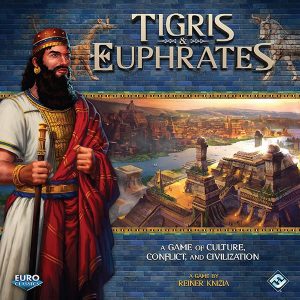Tigris & Euphrates Review

By MARK WILSON

Year Published: 1997
Players: 2-4
Playing Time: 90 Minutes
Tigris and Euphrates (T&E) is a pillar of board gaming. While the distinction of most popular “modern classics” goes to games like Catan, Ticket to Ride and Carcassonne, gamers that have been in the hobby’s depths for many years or decades will often fondly name T&E as the standard for the glory of older classics. The game’s pedigree includes design credits from none other than Reiner Knizia, designer royalty in the gaming world. According to many, this is his masterpiece.
With such a storied game, there’s nothing I can say that hasn’t been said, but I do think it’s worth revisiting classics in order to keep them fresh in the eyes of modern gamers.
T&E is ostensibly area control, wherein you maneuver one of your four leader markers around the board, controlling certain civilizations and gaining victory points for it, and expanding those civilizations to increase VPs or tighten your hold on them, or perhaps to expand toward other prizes. There’s only a few different types of actions you can take on a turn. Simple enough, right? Well…
The Electoral College in the Fertile Crescent
The strategy is weird. It’s probably going to take you a whole play to wrap your mind around how to begin forming cogent strategies, not because the mechanics are complicated. They aren’t. But it’s because you’re going to have to think differently than you’re used to.
For starters, which of the four tile/leader types you get the least number of points in, that’s your endgame score. Winning, then, isn’t about domination, but rather even-handed balance. It’s knowing when to turn tail and relinquish a civilization to an opponent, but also when to commit to a strike. It’s not uncommon to feel like things are going well, but then looking down halfway through the game and seeing that your score is two. TWO. It’s hilarious, because you’ll soon realize that everyone has this moment during the game, and everyone is vaguely nervous because they’re convinced they don’t have enough to win. It’s a great psychological trick, which will often alter a player’s risk tolerance, and thus alter their penchant for making wild, risky plays.
The second wild card is conflict. Conflict is inevitable and not always a bad thing. Someone will win and will often benefit massively. If you plan it correctly, that beneficiary can be you. Conflicts also change the board’s landscape dramatically, both in terms of who is in charge in various areas, to the physical landscape itself. Large swaths of tiles will be destroyed, redistricting the electoral map of the game’s tactics in real-time.
Actually, the American election isn’t the worst analogy here. Popular vote (most total points) isn’t the determiner. And a civilization that is smaller and less desirable may be just the voting block you need to secure the election, so to speak. Apologies to my non-American audience, but I think the comparison works here, because the way you’ll have to think about attacking the board is similarly nebulous.
This is all magnificent, by the way, in case that wasn’t clear. T&E makes me think differently than other games, and I love that feeling.
Abstract, Deeply Thematic and Brutal
Lack of theme is a frequent talking point here. And sure, it’s abstract as heck. It’s been pointed out to me (shoutout to Dan Thurot, writer of Space-Biff), though, that a game’s “theme” can be different than its setting. The theme here, then, could be seen as the rise and fall of civilizations, and the struggle to maintain dominance in that shifting landscape. In that respect, it’s deeply thematic.
Is that a stretch? Maybe. I’m not always convinced of the divide between theme and setting, but I do think this game evokes a particular feeling well. It’s not “dry,” as might be implied by calling it abstract.
It’s also brutal. One of my favorite things is when someone starts a massive conflict that involves multiple players, then it goes about as horribly as possible for them, then they watch as the players who got dragged in actually reap benefits beyond what was initially anticipated. Once completed, the “before” and “after” states of the board look like an apocalyptic event swept through, and everyone is in a brief, shocked pause while they absorb the new world they have to maneuver within. Sometimes the initiator is me, sometimes not. At the end, though, one or more players have been gut punched. If that gut-punched player is the one who started the conflict, I usually just give an exaggerated shrug and guilty smile and say, “that’s Tigris & Euphrates,” while the Curb Your Enthusiasm theme plays in my head. It’s great.
For clarity, T&E will reward experience, but it’s not inaccessible to new gamers. There’s no way to fully or even partially optimize this one, because the interactive elements are so volatile.
In any case, this is a Euro, even within its conflict mechanics, but one that doesn’t hold your hand. Your final score really could end up being two, for example. T&E is often pointed to when gamers compare the overarching mentality of older Euros to many newer ones that are conflict-averse. I tend to think this dichotomy is overblown; there are so many new titles these days that you can still find entries into every niche, including the “Euro, but unforgiving and combative” style. However, T&E is sort of a poster child for this type of game. Adjust your interest accordingly.
Tigris & Euphrates – Conclusions
There’s an austerity here that we’re not used to, in any era of games. T&E is a game with no bells or whistles beyond what is needed for the core experience. The board is laughably bland (some versions are nicer than others, but the general point stands). The conflicts are swift and brutal, and the point totals are deliberately limited.
As a result, the game feels remote, abstract and aloof to many who don’t immediately connect with its mechanics. For others, they see in T&E a shockingly dense tactical landscape upon which they have myriad options for unexpected tactics and rich, interactive mental (and literal) clashes with other players.
This latter description is the heart of T&E. If you manage to work your way there, it is one of the more vibrant, furiously beating hearts in all of board gaming. If, however, the conflict mechanics, abstracted theme, austere aesthetic or other elements prevent you from being able to sink this deep, it will seem overhyped. I understand both reactions, even though I ultimately only share one of them.
I’m all in. I think the game is glorious, but I also know that it’s a trickier sell than many that are flashier. I hope, though, that newcomers to the hobby continue to discover this one – or similar games like Knizia’s spiritual successor, Yellow & Yangtze – to see what the fuss is all about.
…
For more content, or just to chat, find me on Twitter @BTDungeons, and if you enjoy my work, be sure to subscribe on Youtube!
Share
Recent Posts
Categories
- All (347)
- Announcements (4)
- Board Games (201)
- DMing (28)
- Game Design (16)
- Playing TTRPGs (21)
- Reviews (188)
- RPGs (141)
- Session Reports (90)
- Why Games Matter (9)